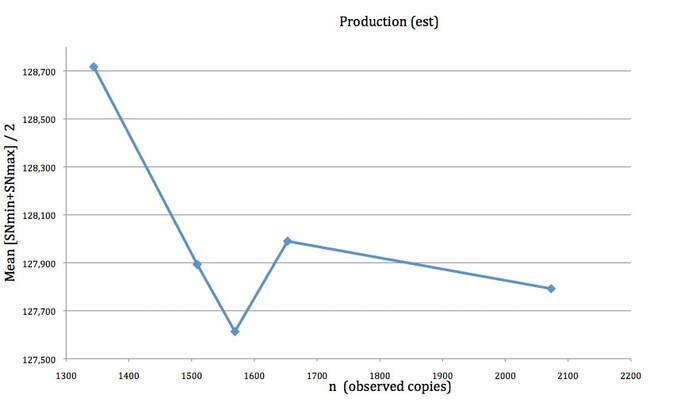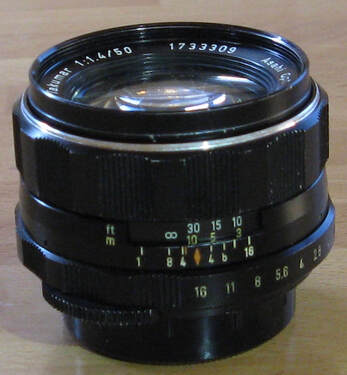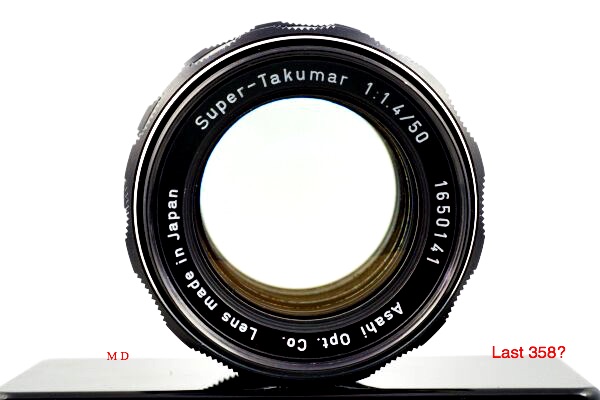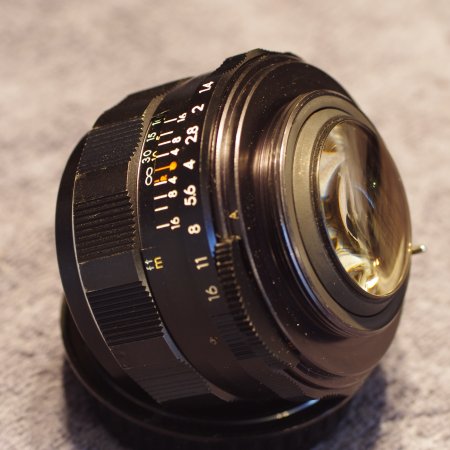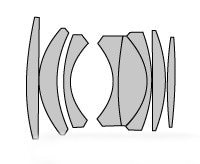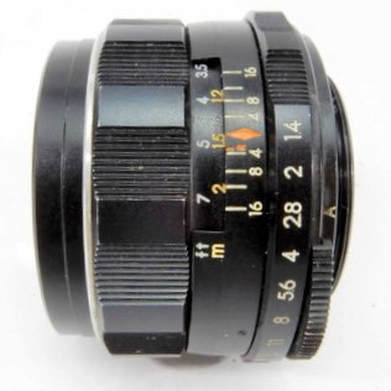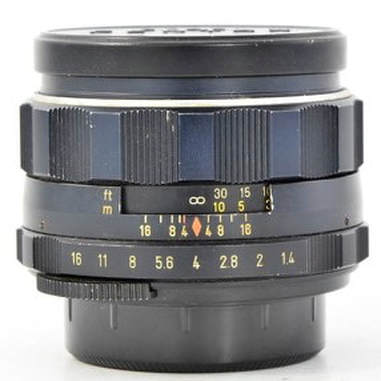S u p e r - T a k u m a r 1 : 1.4 / 50 early & late Model I
Produced 1964 to 1965. Serial Numbers 765xxx - 1733xxx. AOCo Product No. 358. Honeywell Pentax Cat.No.879 Updated Oct. 2023
Produced 1964 to 1965. Serial Numbers 765xxx - 1733xxx. AOCo Product No. 358. Honeywell Pentax Cat.No.879 Updated Oct. 2023
(Research Note: Since 2010 I have seen 1.62% (2073 copies) of the total estimated 128,000 copies made.)
INTRODUCTION
The first model of the fastest standard Super-Takumar. It has 8 elements in 7 groups. The back of the aperture control switch is blank and has no inscribed product number. Because it is distinctive and was sold for two years with the earliest Spotmatic cameras it has gained a reputation for a variety of reasons. Much discussion about this lens centres on how to identify it. It's a popular lens for digital photography and movie-making and, like its improved later versions, those who can justify it will pay a fairly high price for it second hand.
It is not a rare lens but the number of copies in good condition is diminishing. Almost 128,000 copies were made in 105 batches. It has two dominant cosmetic styles and copies in the first three batches vary in minor ways (see below) due to legacy issues. Serial number ranges overlap significantly with the next version of this lens in an irregular way, so it pays to be able to identify them. Aperture switches on this model do not have model numbers inscribed in them but all copies of the next model (37800) do.
Near the end of production a few are assembled with parts that are not standard and keen eyes can spot these (see Notes). Single standard copies with quite high SN's continue to be found among early batches of 37800.
The rear glass of this lens protrudes into cameras further than any other lens because of the extra 8th element. Push-plates for actuating lenses inside cameras were changed from rectangular to curved to provide more space just before the earliest Spotmatic onwards (Photokina 1961?). (Some earlier cameras models were converted as shown by their red "R" rewind buttons ). (Most importantly, no other lenses are affected by this warning.)
An external sign of this compatibility is the red "R" on the rewind button (formerly green). Using this lens model (358) on older cameras with a rectangular push-plate (and a green "R") will damage the rear element.
The first model of the fastest standard Super-Takumar. It has 8 elements in 7 groups. The back of the aperture control switch is blank and has no inscribed product number. Because it is distinctive and was sold for two years with the earliest Spotmatic cameras it has gained a reputation for a variety of reasons. Much discussion about this lens centres on how to identify it. It's a popular lens for digital photography and movie-making and, like its improved later versions, those who can justify it will pay a fairly high price for it second hand.
It is not a rare lens but the number of copies in good condition is diminishing. Almost 128,000 copies were made in 105 batches. It has two dominant cosmetic styles and copies in the first three batches vary in minor ways (see below) due to legacy issues. Serial number ranges overlap significantly with the next version of this lens in an irregular way, so it pays to be able to identify them. Aperture switches on this model do not have model numbers inscribed in them but all copies of the next model (37800) do.
Near the end of production a few are assembled with parts that are not standard and keen eyes can spot these (see Notes). Single standard copies with quite high SN's continue to be found among early batches of 37800.
The rear glass of this lens protrudes into cameras further than any other lens because of the extra 8th element. Push-plates for actuating lenses inside cameras were changed from rectangular to curved to provide more space just before the earliest Spotmatic onwards (Photokina 1961?). (Some earlier cameras models were converted as shown by their red "R" rewind buttons ). (Most importantly, no other lenses are affected by this warning.)
An external sign of this compatibility is the red "R" on the rewind button (formerly green). Using this lens model (358) on older cameras with a rectangular push-plate (and a green "R") will damage the rear element.
DESCRIPTION
|
VARIATION
- The earliest Spotmatic Operating Manual (J) contains illustrations of two early cosmetic forms of the 8 element 1.4/50mm Super-Takumar (358) available only with this camera in 1964. The first form retains the cosmetic style of previous lens types with an orange "lollipop" as the centre of the depth of field (DOF) gauge and a short orange bar ending next to the orange letter "R" between this central marker and the f4 position marker; the first white bar on the LHS of the lollipop. The second form has no orange letter R (through later abbreviation) and the orange "lollipop" is replaced with an orange trapezoid in the centre of the DOF scale (even in some copies in the first batches). The trapezoid is colloquially known as a "diamond" shape. The "R" and the "lollipop" persist on a very small number of copies up to the 9th batch, or SN 1080001.
- Early "transitional" copies with legacy features (referred to as varieties A, B and C) are uncommon (estimated 3,000 copies). By far the majority of this first model are designated D "early", with round lettering; or D "late", with oval lettering.
- In the first batch a very small number of initial copies are "A" and have half stops between all aperture positions. First copies of B, C and D appear later in this batch.
- The first and last of these half stops (viz. between f1.4 - f2 and f11 - f16) are absent in varieties B, C and D. Copies in the next three batches consist only of varieties B, C or D. See home.a00.itscom.net/shisan12/st5014hist.htm for a fuller discussion of variations among copies of Super-Takumar 1.4/50 in Japanese text.
- According to observed serial numbers the varieties A, B, C and D (round lettering) appeared in the first batch for sale with the early Spotmatic cameras and illustrate the rapid evolution of styling in this lens model (A > B> C >D(round)) during the first 9 batches. Some were designed as early as 1962 with the developing Spotmatic and could be seen as prototypes.
- During the development of early varieties the number of grooves in the aperture rings varied from 10 to 11 and finally 9 (i.e. A(9/11). The focus ring formula is consistently F(10/12) throughout production. (See Collection for formulae explanation).
- Later in the production period of this lens the D (round lettering or "printing") to D (oval lettering or "cursive") font, loss of the comma after the maker's name, and moving the serial number to follow the name, altered the appearance of all Super-Takumars, including this lens. The last batch with wholly round lettering forming the name is marked (as below) but three following batches (from SN1337xxx to SN1340xxx) reveal the transition; some with either oval or round lettering as available parts were used. An interesting aspect of this change is that I know of no oval or round parts which were assembled together on the same copy during production of this or any other Super-Takumars from this period. A process well controlled? If any, they would appear in the SN gap above.
NOTES
- LHS (Above) First batches include copies that show the IR marker on the DOF gauge with a red "R" still beneath it. This is legacy version "C" from an early batch. The R is lost completely after the ninth batch (SN1079763) allowing a narrow gauge and petite trapezoid. The font for numerals is large with 4 "closed".
- RHS (Above) Final large batch e.g. 1591XXX contains copies with available but irregular parts 💙. The LHS of depth of field gauge shows the red IR marker placed correctly in relation to other markings to signify a 358 (this version), but, a 38700 DOF gauge plan (belonging to the next version) has been used to do it! The f=4 finds itself (misplaced) beneath the IR mark as a result. The font for numerals is oval and the 4 "open". This copy is an 8 element 358, one of the very few final copies with this arrangement. The picture is SN 1591856 (without a product number and with a protruding rear lens). It is not a "hybrid" (because no true hybrid is possible); but a copy assembled from available parts that was not wasted, and it's special. A reminder of a time without wasteful attitudes?
- Re-addressing the issue of "hybrid" where parts of both models are combined during the change-over; only two scenarios matter. One has an extra protruding rear lens; the other has not and is labelled with its model number.
- The 7 element lenses all (?) have their product number "37800" inscribed into the back of their aperture switches and are easily identified. They were the first Super-Takumars to be so labelled.
- Parts for assembling lenses were made in batches, and, when these were used more were ordered according to the "Just in time" method of production invented by Japanese industry. It avoids parts stockpiling in warehouses; a costly waste of space. A consequence of this method is that leftover or alternative parts might need to be used to meet immediate production targets. This effect is also evident in model changeover between some other lenses (e.g. 43541 Super-Takumar to 43542 Super-Multi-Coated Takumar 1:3.5/135mm and others).
|
Opposite is the key to identifying the last and most common form of this lens.
It's a D "late" with the orange bar (IR marker) to the RHS of the open 4 (between the 4 and the orange "diamond"), oval lettering, shallow gauge and medium-sized diamond (trapezoid). (It has a 358 DOF gauge, no model number inscribed on the back side of the aperture switch and protruding rear glass) The photograph was donated by the owners of SN 1650141and 1733309 the last known copies shown at the top of this page. |
LENS PRODUCTION (∑ lenses) ∑n = 2073 Serial Numbers observed in 105 Batches covering 115,901 SN min. < ∑ lenses < 139,684 SN max.
SN min. = accumulated total of serial numbers observed within 105 batches
SN max. = accumulated total of serial numbers observed between adjacent batches of other lenses.
Two main Styles: ▼ Round lettering; SN before name; comma after maker's name. ▲ / ▼ ▼ Oval lettering; SN follows name; no comma after maker's name. ▲▲
Underlined batches have copies of both styles. Otherwise:F(10/12), A(9/11) are consistent after batch 4.
Batches 1-4 contain copies with legacy styling and extra half stops may be available.
💙 A few (at least 10 below) final copies substituted the depth of field gauge plan of the next model (37800) when the equivalent part was unavailable during a long transition period.
SN min. = accumulated total of serial numbers observed within 105 batches
SN max. = accumulated total of serial numbers observed between adjacent batches of other lenses.
Two main Styles: ▼ Round lettering; SN before name; comma after maker's name. ▲ / ▼ ▼ Oval lettering; SN follows name; no comma after maker's name. ▲▲
Underlined batches have copies of both styles. Otherwise:F(10/12), A(9/11) are consistent after batch 4.
Batches 1-4 contain copies with legacy styling and extra half stops may be available.
💙 A few (at least 10 below) final copies substituted the depth of field gauge plan of the next model (37800) when the equivalent part was unavailable during a long transition period.
|
▼ 765144 to 766220 (26/ 1076) A (all half stops) plus copies of B, C and D. 967642 to 968572 (30/ 930) B (2 half stops missing) plus copies of C and D. 977330 to 978200 (36/ 870) B and C (diamond+R) 998113 to 999521 (41/ 1408) C 1000773 (1/ 1) 1002503 (1/ 1) 1031160 to 1033068 (53/ 1908) 1062093 to 1064179 (67/ 2086) 1079719 to 1081191 (42/ 1472) 1115170 to 1116098 (16/ 928) 1118122 to 1118968 (30/ 846) 1123559 to 1124495 (24/ 936) 1134198 to 1135173 (27/ 975) 1140723 to 1141779 (34/ 1056) 1155436 to 1156220 (19/ 784) 1160359 to 1161228 (21/ 869) 1164784 to 1165612 (22/ 828) 1165754 to 1165762 (2/ 8) 1178951 to 1179926 (27/ 975) 1194151 to 1194936 (15/ 785) 1204488 (1/ 1) 1211923 to 1213675 (26/ 1752) 1220118 to 1222608 (57/ 2490) 1222670 to 1222778 (5/ 108) 1229594 (1/ 1) 1238882 to 1239679 (15/ 797) 1244757 (1/ 1) 1251486 to 1252454 (18/ 968) 1275050 to 1275773 (9/ 723) 1278414 (1/ 1) 1279826 to 1280708 (11/ 882) 1283298 to 1283372 (2/ 74) 1283597 to 1284470 (18/ 873) 1287811 to 1288645 (17/ 834) 1296245 to 1296975 (15/ 730) |
Serial Numbers in 105 Batches (n /SN range)
Collection 1310185 to 1311139 (18/ 954) 1314186 to 1315132 (25/ 946) 1327303 to 1327711 (7/ 408) 1329153 to 1329364 (7/ 211) 1330480 to 1331365 (20/ 885) 1332157 to 1332621 (11/ 464) 1334671 to 1334862 (6/ 191) 1335140 to 1336017 (19/ 877) ▲ / ▼ ▼ 1336986 to 1337180 (5/ 194) 1337375 to 1340828 (61/ 3453) 1340009 1342804 to 1343157 (6/ 353) 1343972 to 1344856 (23/ 884) 1345003 to 1345314 (6/ 311) 1347101 to 1347758 (6/ 657) 134875 to 1348082 (2/ 7) 1349021 to 1349695 (8/ 674) 1353552 to 1358107 (58/ 4555) 1360329 (1/ 1) 1360986 (1/ 1) 1363311 (1/ 1) 1369645 (1/ 1) 1374727 to 1394694 (282/ 19967) 1397455 to 1402413 (60/ 4958) 1416183 to 1418001 (32/ 1818) 37800 SN begins 1418175 to 1418729 (4/ 554)? 1420237 to 1420284 (2/ 47) 1421013 (1/ 1) 1421553 (1/ 1) 1423571 (1/ 1) 1450975 (1/ 1) 1452921 (1/ 1) 1476074 to 1496044 (268/ 19970) 1509835 (1/ 1)💙 1547621 (1/ 1) 1548686 to 1551425 (35/ 2739) |
1551446 to 1552423 (23/ 977) 1552464 to 1554556 (34/ 2092) 1554602 to 1554629 (2/ 25) 1555077 to 1558589 (57/ 3512) 1572001 to 1576371 (59/ 4370) (💙 1572262) 1576665 to 1577078 (11/ 413) 1577092 to 1583064 (95/ 5972) (💙 1580883) 1583327 to 1584066 (16/ 739) 1584399 (1/ 1) 1585011 to 1585547 (6/ 536) 1585626 (1/1) 1585961(1/1) 1586344 to 1586607 (4/ 263) 1587316 (1/ 1) 1587465 (1/ 1) 1587705 to 1587745 (2/ 40) 1588435 to 1588567 (3/ 132) 1588721 to 1589183 (11/ 462) 1589516 (1/ 1) 1589653 to 1589984 (4/ 331) 1590107 (1/ 1) 1590324 (1/ 1) 1590475 (1/ 1) 1590756 to 1590843 (3/ 87) 1591063 to 1591478 (7/ 415) (💙1591478) 1591841 to 1591987 (3/ 146) 1643013 (1/ 1) 💙 1645822 to 1645841 (2/ 19) 💙 1647754 (1/ 1) 1647853 (1/ 1) 1647891 to 1648180 (2/ 289)💙 1648460 (1/ 1) 1648818 (1/ 1) 1648929 (1/ 1) 1650141 (1/ 1) 1733309 (1/ 1) ▲▲ |
MARKETING
The Asahi Pentax Spotmatic Operating Manual (61015) and Honeywell Pentax Spotmatic Operating Manual (61014) has Important notes on page 20-21, or 18-19, respectively. Different editions give different warnings. Note 7 from August 1966 to August, September and November 1967 and 1968 is;
"Do not use the new Super-Takumar 50mm F/1.4 lens with any other camera or any other Asahi Pentax model except with models SV and S1a, having orange-coloured "R" marking on the film rewind knob, or you will damage the rear element of the lens."
"Do not use the new Super-Takumar 50mm f/1.8 lens with any other camera or any other Honeywell Pentax model except with models H3v and H1a, having orange-colored "R" marking on the film rewind knob, or you will damage the rear element of the lens."
Later editions (61015) and (06046) give different warnings. Note 7 in April and July 1969 and 1970 is;
"The Super-Takumar 50mm f/1.4 lens is made for use with the Spotmatic. It can be used with only two other cameras: the Asahi Pentax SV and S1a with an orange-coloured "R" marking on the film rewind knob. Use with any other camera will damage the rear element of the lens."
The Honeywell Pentax Spotmatic II Operating manual (06466) page 18-19 continued over-explaining.
Note 5 in July 1973 is;
"Primarily made for use with the Spotmatic II, the 50mm f/1.4 Super-Multi-Coated Takumar can also be used with the original Spotmatic, Spotmatic IIa, and models SL and SP500. Further, they can be used with two other cameras: Honeywell Pentax H3v and H1a with an orange-coloured R marking on the film rewind knob. Use with any other camera may damage the rear lens element."
All the above were printed in Japan.
The Honeywell Pentax Cameras, Lenses, and Accessories (P1009) of October 1970 printed in USA omitts this issue.
So, logically, this lens (358) is too long for camera models with a green-coloured rewind knob. (Mind! It's probably too late to discover this when removing film!)
The second and subsequent statements (1969,1973) are globally incorrect because they implicate (unnecessarily) all subsequent new 7 element models of the 50mm f/1.4. Attempts to simplify marketing ignore the differences between subsequent lens models far as the customer is concerned. So the literature is opaque about this issue and remains a topic of discussion even now (See below).
(An earlier compatibility warning exists about using some Auto-Takumar 55mm f/1.8 lenses with SN below 462500 (345 types 1, 2, and 3) on SV and S1a cameras. See lens page. It points to simple logic, that automatic functions on new automatic lenses will not operate on previous camera models.) Clear message!
The Asahi Pentax Spotmatic Operating Manual (61015) and Honeywell Pentax Spotmatic Operating Manual (61014) has Important notes on page 20-21, or 18-19, respectively. Different editions give different warnings. Note 7 from August 1966 to August, September and November 1967 and 1968 is;
"Do not use the new Super-Takumar 50mm F/1.4 lens with any other camera or any other Asahi Pentax model except with models SV and S1a, having orange-coloured "R" marking on the film rewind knob, or you will damage the rear element of the lens."
"Do not use the new Super-Takumar 50mm f/1.8 lens with any other camera or any other Honeywell Pentax model except with models H3v and H1a, having orange-colored "R" marking on the film rewind knob, or you will damage the rear element of the lens."
Later editions (61015) and (06046) give different warnings. Note 7 in April and July 1969 and 1970 is;
"The Super-Takumar 50mm f/1.4 lens is made for use with the Spotmatic. It can be used with only two other cameras: the Asahi Pentax SV and S1a with an orange-coloured "R" marking on the film rewind knob. Use with any other camera will damage the rear element of the lens."
The Honeywell Pentax Spotmatic II Operating manual (06466) page 18-19 continued over-explaining.
Note 5 in July 1973 is;
"Primarily made for use with the Spotmatic II, the 50mm f/1.4 Super-Multi-Coated Takumar can also be used with the original Spotmatic, Spotmatic IIa, and models SL and SP500. Further, they can be used with two other cameras: Honeywell Pentax H3v and H1a with an orange-coloured R marking on the film rewind knob. Use with any other camera may damage the rear lens element."
All the above were printed in Japan.
The Honeywell Pentax Cameras, Lenses, and Accessories (P1009) of October 1970 printed in USA omitts this issue.
So, logically, this lens (358) is too long for camera models with a green-coloured rewind knob. (Mind! It's probably too late to discover this when removing film!)
The second and subsequent statements (1969,1973) are globally incorrect because they implicate (unnecessarily) all subsequent new 7 element models of the 50mm f/1.4. Attempts to simplify marketing ignore the differences between subsequent lens models far as the customer is concerned. So the literature is opaque about this issue and remains a topic of discussion even now (See below).
(An earlier compatibility warning exists about using some Auto-Takumar 55mm f/1.8 lenses with SN below 462500 (345 types 1, 2, and 3) on SV and S1a cameras. See lens page. It points to simple logic, that automatic functions on new automatic lenses will not operate on previous camera models.) Clear message!
LITERATURE
Early compatibility warnings for this lens (See INTRODUCTION) in general literature are poorly handled They reinforce the message that only makers instructions should be consulted. All kinds of customers need to understand an issue, not only a target market!
The first edition of Asahi Pentax Way (1966) gives the wrong message. The error is corrected in The Honeywell Pentax Way (1968). Another attempt in the Asahi Pentax Way (1967) (second edition) misses the point; seeming to imply that subsequent 7 element lenses are not backward compatible. (Following the lead of the generalised makers instructions in 1969.) This continues in Asahi Pentax Way up to the eleventh edition in (1979) until it is omitted.
The Asahi Pentax Guide Emanuel W. D. issues a warning without adequate explanation and declares the 8 element (358) to be the lens for the Spotmatic from the 1965 edition until 1979. Some editions temporarily list 7 element lenses, including the final SMC version, and continue the warning about the original 8 element lens (358) ignoring any ideas about succession.
Close editing fails to give any back story (so customers are mislead by poor, limited communication); treating customers as if they have 2 second attention spans. Posterity has to figure it out alone in the end. If this page is too simplistic or misleads I welcome correction. Oh, for communicators who communicate.
Later enlightened authors (e.g. Gerjan van Oosten (1999)) realised (358) suits only cameras it was design to fit and is too long for others.
Early compatibility warnings for this lens (See INTRODUCTION) in general literature are poorly handled They reinforce the message that only makers instructions should be consulted. All kinds of customers need to understand an issue, not only a target market!
The first edition of Asahi Pentax Way (1966) gives the wrong message. The error is corrected in The Honeywell Pentax Way (1968). Another attempt in the Asahi Pentax Way (1967) (second edition) misses the point; seeming to imply that subsequent 7 element lenses are not backward compatible. (Following the lead of the generalised makers instructions in 1969.) This continues in Asahi Pentax Way up to the eleventh edition in (1979) until it is omitted.
The Asahi Pentax Guide Emanuel W. D. issues a warning without adequate explanation and declares the 8 element (358) to be the lens for the Spotmatic from the 1965 edition until 1979. Some editions temporarily list 7 element lenses, including the final SMC version, and continue the warning about the original 8 element lens (358) ignoring any ideas about succession.
Close editing fails to give any back story (so customers are mislead by poor, limited communication); treating customers as if they have 2 second attention spans. Posterity has to figure it out alone in the end. If this page is too simplistic or misleads I welcome correction. Oh, for communicators who communicate.
Later enlightened authors (e.g. Gerjan van Oosten (1999)) realised (358) suits only cameras it was design to fit and is too long for others.
